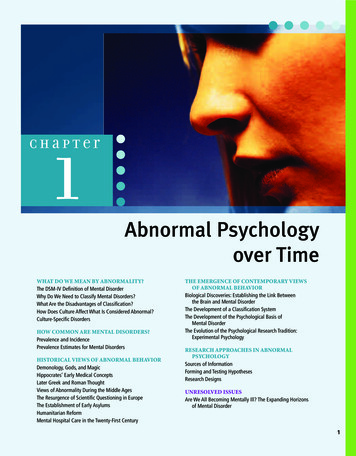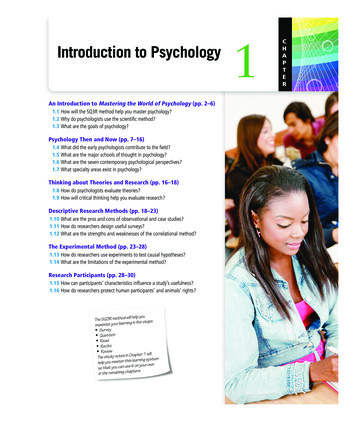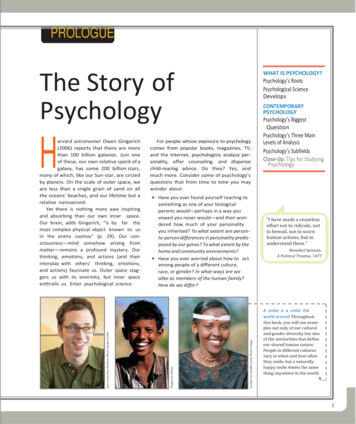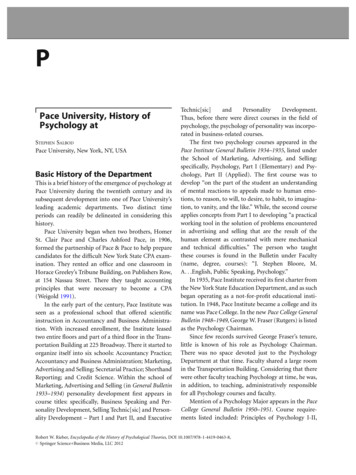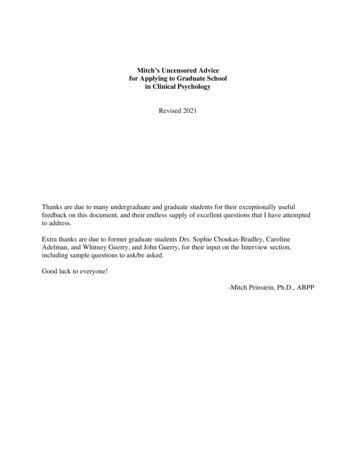
Transcription
PsychologyA01 WADE4316 11 SE FM.indd 112/20/12 4:47 AM
A01 WADE4316 11 SE FM.indd 212/20/12 4:47 AM
PsychologyEleventh EditionCarole WadeDominican University of CaliforniaCarol TavrisMaryanne GarryVictoria University of WellingtonBoston Columbus Indianapolis New York San Francisco Upper Saddle RiverAmsterdam Cape Town Dubai London Madrid Milan Munich Paris Montréal TorontoDelhi Mexico City São Paulo Sydney Hong Kong Seoul Singapore Taipei TokyoA01 WADE4316 11 SE FM.indd 312/20/12 4:47 AM
Editorial Director: Craig CampanellaEditor in Chief: Jessica MosherExecutive Editor: Stephen FrailManaging Editor, Editorial: Judy CasilloEditorial Assistant: Caroline BeimfordVice President, Director of Marketing: Brandy DawsonExecutive Marketing Manager: Nicole KunzmannMarketing Assistant: Frank AlarconProgram Manager: Maureen RichardsonManaging Editor Production: Denise ForlowProject Manager, Production: Annemarie FranklinCopyeditor: Heather McElwainSenior Operations Specialist: Diane M. PeiranoSenior Art Director: Leslie OsherText and Cover Designer: Ilze LemesisCover Art: LatinStock Collection/AlamySenior Media Editor: Pete SabatiniMedia Project Manager: Pamela WeldinFull-Service Project Management: Lindsay Bethoney/PreMediaGlobalCompositon: PreMediaGlobalPrinter/Binder: R.R. Donnelley/WillardCover Printer: Lehigh-Phoenix Color/HagerstownText Font: 10/13 JansonCredits and acknowledgments borrowed from other sources and reproduced, with permission, inthis textbook appear on appropriate page within text (or beginning on p. C-1).Copyright 2014, 2011, 2008, by Pearson Education, Inc., 1 Lake Street, Upper Saddle River,NJ 07458. All rights reserved. Manufactured in the United States of America. This p ublicationis protected by Copyright, and permission should be obtained from the publisher prior to any prohibited reproduction, storage in a retrieval system, or transmission in any form or by anymeans, electronic, mechanical, photocopying, recording, or likewise. To obtain permission(s) to usematerial from this work, please submit a written request to Pearson Education, Inc., Permissions Department, 1 Lake Street, Upper Saddle River, NJ 07458.Many of the designations by manufacturers and sellers to distinguish their products are claimedas trademarks. Where those designations appear in this book, and the publisher was aware of a trademark claim, the designations have been printed in initial caps or all caps.Library of Congress Cataloging-in-Publication DataWade, Carole.Psychology / Carole Wade, Dominican University of California, Carol Tavris, Maryanne Garry,Victoria University of Wellington. —Eleventh Edition.pages cm.ISBN-13: 978-0-205-25431-61. Psychology—Textbooks. I. Tavris, Carol. II. Garry, Maryanne. III Title.BF121.W27 2013150—dc23201204169710 9 8 7 6 5 4 3 2 1Student Hardcover EditionISBN-10: 0-205-25431-4ISBN-13: 978-0-205-25431-6Books à la Carte EditionISBN-10: 0-205-87333-2ISBN-13: 978-0-205-87333-3A01 WADE4316 11 SE FM.indd 412/20/12 4:47 AM
To Howard, whose support has made it all possible.Carole WadeFor Ronan, in loving memory.Carol TavrisTo Devon, Beth, and all the apples.Maryanne GarryA01 WADE4316 11 SE FM.indd 512/20/12 4:47 AM
Brief ContentsFrom the Authors xiiFrom the Publisher xviAuthors’ Acknowledgments xx1What Is Psychology? 22How Psychologists Do Research 323Genes, Evolution, and Environment 684The Brain and Nervous System 985Body Rhythms and Mental States 1386Sensation and Perception 1747Learning and Conditioning 2188Behavior in Social and Cultural Context 2549Thinking and Intelligence 29810Memory 33811Emotion, Stress, and Health 38012Motivation 42013Development Over the Life Span 46014Theories of Personality 50415Psychological Disorders 54216Approaches to Treatment and Therapy ��C-1Name Index NI-1Subject Index SI-1viA01 WADE4316 11 SE FM.indd 612/20/12 4:47 AM
ContentsFrom the Authors xiiFrom the Publisher xviAuthors’ AcknowledgmentsKeeping the Enterprise Ethical 61The Ethics of Studying Human BeingsThe Ethics of Studying Animals 62xx1 What Is Psychology?Taking Psychology with YouLying with Statistics2Psychology, Pseudoscience, and Popular Opinion 5Thinking Critically and Creatively about Psychology 6Psychology’s Past: From the Armchair to theLaboratory 15The Birth of Modern Psychology 15Three Early Psychologies 163Genes, Evolution, andEnvironment 6870The Genetics of Similarity 74Evolution and Natural Selection 74Innate Human Characteristics 77What Psychologists Do 21Psychological Research 22Psychological Practice 23Psychology in the Community 26 Biology, culture, and Psychology64Unlocking the Secrets of GenesThe Human Genome 70Epigenetics 72Psychology’s Present: The Four Perspectives ofPsychological Science 18Our Human Heritage: Courtship and MatingEvolution and Sexual Strategies 79The “Genetic Leash” 8026272 How Psychologists Do Research32What Makes Psychological Research Scientific? 34Descriptive Studies: Establishing the FactsCase Studies 39Observational Studies 40Tests 41Surveys 4338 BIOLOGY and Intellect8788Beyond Nature versus Nurture93Taking Psychology with YouShould You Have Genetic Testing?944 The Brain and Nervous System98The Nervous System: A Basic Blueprint 101The Central Nervous System 101The Peripheral Nervous System 10150 Culture and Research 53Evaluating the Findings 55Descriptive Statistics: Finding Out What’s SoInferential Statistics: Asking “So What?” 56Interpreting the Findings 57Our Human Diversity: The Case ofIntelligence 87Genes and Individual DifferencesThe Question of Group Differences 89The Environment and Intelligence 91Correlational Studies: Looking for Relationships 45Measuring Correlations 45Cautions about Correlations 47Experiments: Hunting for Causes 49Experimental Variables 49Experimental and Control ConditionsExperimenter Effects 5179The Genetics of Difference 84The Meaning of Heritability 84Computing Heritability 85Taking Psychology with YouThe Nine Secrets of Learning6255Communication in the Nervous System 104The Structure of the Neuron 104Neurogenesis: The Birth of Neurons 105How Neurons Communicate 107Chemical Messengers in the Nervous System108viiA01 WADE4316 11 SE FM.indd 712/20/12 4:47 AM
viii Contents6 Sensation and PerceptionMapping the Brain 112Intervening in the Brain and ObservingBehavior 112Intervening in Behavior and Observing theBrain 113Our Sensational Senses 176The Riddle of Separate SensationsMeasuring the Senses 178Sensory Adaptation 180Sensing without Perceiving 182A Tour through the Brain 116The Brain Stem 117The Cerebellum 118The Thalamus 118The Hypothalamus and the Pituitary Gland 118The Amygdala 118The Hippocampus 119The Cerebrum 119The Two Hemispheres of the Brain 123Split Brains: A House Divided 123The Two Hemispheres: Allies or Opposites?The Flexible Brain 127Experience and the BrainHearing 195What We Hear 195An Ear on the World 196Constructing the Auditory World1261271301335 Body Rhythms and Mental StatesBiological Rhythms: The Tides of Experience 140Circadian Rhythms 140Moods and Long-Term Rhythms 143 Culture and PMS 144The Rhythms of Sleep 147The Realms of Sleep 147Why We Sleep 149Exploring the Dream World 153Dreams as Efforts to Deal with Problems 154Dreams as Thinking 155Dreams as Interpreted Brain Activity 156Evaluating Dream Theories 157The Riddle of Hypnosis 158The Nature of Hypnosis 159Theories of Hypnosis 160 BIOLOGY and Hypnosis 162Consciousness-Altering Drugs 164Classifying Drugs 164The Physiology of Drug Effects 167The Psychology of Drug Effects 168Taking Psychology with YouThe Drug DebateA01 WADE4316 11 SE FM.indd 8171186197Other Senses 199Taste: Savory Sensations 199Smell: The Sense of Scents 201Senses of the Skin 203The Mystery of Pain 203Taking Psychology with YouCosmetic Neurology: Tinkering with the Brain176Vision 183What We See 183An Eye on the World 183Why the Visual System Is Not a CameraHow We See Colors 187Constructing the Visual World 188 Culture and the Brain 129Are There “His” and “Hers” Brains?174 BIOLOGY and the Power of Placebos 205138The Environment Within206Perceptual Powers: Origins and Influences 208Inborn Abilities 208Critical Periods 208Psychological and Cultural Influences 209 Culture and Perception 211Perception without Awareness212Taking Psychology with YouExtrasensory Perception: Reality or Illusion?2147 Learning and Conditioning218Classical Conditioning 220New Reflexes from Old 221Principles of Classical Conditioning 222What Is Actually Learned in ClassicalConditioning? 223Classical Conditioning in Real Life 225Learning to Like 225Learning to Fear 226Accounting for Taste 228Reacting to Medical Treatments 228Operant Conditioning 230The Birth of Radical Behaviorism23012/20/12 4:47 AM
ContentsThe Consequences of Behavior231Reasoning Rationally 306Principles of Operant Conditioning 234Skinner: The Man and the Myth 238Barriers to Reasoning Rationally 308Exaggerating the Improbable (and Minimizing theProbable) 309Avoiding Loss 310The Fairness Bias 311Operant Conditioning in Real Life 240The Pros and Cons of Punishment 240The Problems with Reward 243Learning and the Mind 246Latent Learning 247Social-Cognitive Learning Theories BIOLOGY and Economic Choice247Taking Psychology with YouDoes Media Violence Make You Violent?2508 Behavior in Social and CulturalContext254Roles and Rules 256The Obedience Study 257The Prison Study 260Why People Obey 261311The Hindsight Bias 312The Confirmation Bias 313Mental Sets 314The Need for Cognitive Consistency 314Overcoming Our Cognitive Biases 316Measuring Intelligence: The PsychometricApproach 318The Invention of IQ Tests 318 Culture and Intelligence Testing 320Social Influences on Beliefs and Behavior 263Attributions 263Attitudes 266 BIOLOGY and Beliefs 268Persuasion or “Brainwashing”?: The Case of SuicideBombers 270Individuals in Groups 272Conformity 273Groupthink 274The Wisdom and Madness of CrowdsAltruism and Dissent 276Dissecting Intelligence: The Cognitive ApproachElements of Intelligence 323Motivation, Hard Work, and IntellectualSuccess 326Animal Minds 328Animal Intelligence 328Animals and Language 330Thinking about the Thinking of Animals27533210 Memory334338Reconstructing the Past 340The Manufacture of Memory 341The Conditions of Confabulation 343Memory and the Power of SuggestionThe Eyewitness on Trial 345Children’s Testimony 346Group Conflict and Prejudice 283The Origins of Prejudice 284Defining and Measuring Prejudice 287Reducing Conflict and Prejudice 290344In Pursuit of Memory 349Measuring Memory 349Models of Memory 351The Question of Human Nature 292The Three-Box Model of Memory 352The Sensory Register: Fleeting Impressions 353Short-Term Memory: Memory’s NotePad 353Long-Term Memory: Memory’s Storage System 355Taking Psychology with You2949 Thinking and Intelligence298Thought: Using What We Know 300The Elements of Cognition 300How Conscious Is Thought? 302Problem Solving and Decision MakingThe Biology of Memory 359Changes in Neurons and Synapses 359Where Memories are Made 360Hormones, Emotion, and Memory 361304How We RememberA01 WADE4316 11 SE FM.indd 9323Taking Psychology with YouBecoming More CreativeUs versus Them: Group Identity 279Ethnic Identity 279Ethnocentrism 280Stereotypes 281Dealing with Cultural Differencesix36312/20/12 4:47 AM
x ContentsEffective Encoding 364Rehearsal 364Retrieval Practice 365Remembering the Secrets of LearningEnvironmental Influences on Weight Culture and the Ideal Body 427The Body as Battleground: Eating Disorders366The Social Animal: Motives to LoveThe Biology of Love 430The Psychology of Love 432Gender, Culture, and Love 435Why We Forget 367Decay 368Replacement 368Interference 369Cue-Dependent Forgetting 370The Repression Controversy 371Autobiographical Memories 373Childhood Amnesia: The Missing Years 373Memory and Narrative: The Stories of Our Lives436 BIOLOGY and Sexual Orientation 44337537611 Emotion, Stress, and HealthThe Competent Animal: Motives to AchieveThe Effects of Motivation on Work 447The Effects of Work on Motivation 451380 BIOLOGY and Lie Detection 389Emotion and the Mind 391How to Attain Your Goals45613 Development over theLife Span460From Conception through the First YearPrenatal Development 462The Infant’s World 464Attachment 465The Nature of Stress 398Stress and the Body 399Stress and the Mind 402Cognitive Development 469Language 470Thinking 474 Culture and Control 405Stress and Emotion 406Hostility and Depression: Do They Hurt? 407Positive Emotions: Do They Help? 408Emotional Inhibition and Expression 408Taking Psychology with YouHow Much Control Do We Have over Our Emotions andOur Health? 41612 Motivation420The Hungry Animal: Motives to Eat 422The Biology of Weight 422A01 WADE4316 11 SE FM.indd 10453Taking Psychology with YouEmotion and Culture 394How Culture Shapes Emotions 394Communicating Emotions 395Gender and Emotion 396Coping with Stress 410Solving the Problem 411Rethinking the Problem 412Drawing on Social Support 412446Motives, Values, and the Pursuit of HappinessThe Nature of Emotion 382Emotion and the Body 382428430The Erotic Animal: Motives for SexThe Biology of Desire 437The Psychology of Desire 439Gender, Culture, and Sex 441Taking Psychology with YouMemory and Myth424462Moral Development 478Gender Development 482Gender Identity 482Influences on Gender DevelopmentAdolescence 487The Physiology of Adolescence483488 BIOLOGY and the Adolescent Brain 489The Psychology of AdolescenceAdulthood 491Stages and Ages 492The Transitions of LifeOld Age 495489494The Wellsprings of Resilience 498Taking Psychology with YouBringing Up Baby49912/20/12 4:47 AM
Contents14 Theories of PersonalityPersonality Disorders 560Borderline Personality Disorder 560Antisocial Personality Disorder 561Psychopathy: Myths and Evidence 561504Psychodynamic Theories of Personality 506Freud and Psychoanalysis 506Other Psychodynamic Approaches 509Evaluating Psychodynamic Theories 511Drug Abuse and Addiction 564Biology and Addiction 565Learning, Culture, and Addiction 566Debating the Causes of Addiction 569The Modern Study of Personality 513Popular Personality Tests 513Core Personality Traits 514Dissociative Identity DisorderGenetic Influences on Personality 518571Schizophrenia 574Symptoms of Schizophrenia 574Origins of Schizophrenia 575 Biology and Animal Traits 518Heredity and Temperament 519Heredity and Traits 520Evaluating Genetic Theories 520Taking Psychology with YouMental Disorder and Personal Responsibility578Environmental Influences on Personality 522Situations and Social Learning 522Parental Influence—and Its Limits 523The Power of Peers 52516 Approaches to Treatment andCultural Influences on Personality 526Culture, Values, and Traits 527Biological Treatments for Mental DisordersThe Question of Drugs 584Direct Brain Intervention 589Therapy Culture and Violence 529Evaluating Cultural Approaches 532The Inner Experience 533Humanist Approaches 533Narrative Approaches 535Evaluating Humanist and Narrative Approaches53815 Psychological DisordersDiagnosing Mental Disorders 544Dilemmas of Diagnosis 545 Culture and Mental Illness 548Dilemmas of Measurement 549Anxiety Disorders 552Anxiety and Panic 552Fears and Phobias 554Obsessions and CompulsionsMood Disorders 556Depression 556Bipolar Disorder 557Origins of Depression 557A01 WADE4316 11 SE FM.indd 11535582584Major Schools of Psychotherapy 592Psychodynamic Therapy 592Behavior and Cognitive Therapy 593Humanist and Existential Therapy 597Family and Couples Therapy 598Evaluating Psychotherapy 600Taking Psychology with YouHow to Avoid the “Barnum Effect”xi555542 Culture and Psychotherapy601The Scientist–Practitioner GapWhen Therapy Helps 604602 BIOLOGY and Psychotherapy 607When Therapy Harms608The Value and Values of Psychotherapy611Taking Psychology with YouBecoming a Smart Consumer of Psychological redits C-1Name Index NI-1Subject Index SI-112/20/12 4:47 AM
From the AuthorsFrom the very first edition of our book, our primary goal has been the integrationof critical and scientific thinking into the fabric of our writing, a goal that webelieve is more important now than ever. A textbook is not a laundry list of items, andits writers are not simply reporters. For us, the most important job of an introductorytextbook in psychology is to help students learn to think like a psychologist, and tounderstand why scientific and critical thinking is so important to the decisions theymake in their own lives. Today, for example, the public in general, and students inparticular, need to learn about the astonishing new developments in neuroscience, butthey also need to learn to think intelligently about them. Not all of these developmentsare as dramatic or applicable as they are often made to appear in the popular press. Notall of the findings that are reported are based on good science, no matter how fancy thetools that produced them.Changes in the 11th EditionIn this 11th edition of Psychology, we have welcomed aboard a third author, MaryanneGarry, professor of psychology at Victoria University of Wellington, New Zealand.Dr. Garry’s breadth of knowledge in the areas of memory, cognition, and learning havenot only enhanced this edition’s coverage of these fields but also improved the book’spedagogical focus. In particular, we have introduced the read-recite-review (3R)approach, which is grounded in empirical research demonstrating its benefits on student learning and memory for the material (McDaniel, Howard, & Einstein, 2009). Incontrast to the usual “read and cram before tests” approach that students often rely on,this method requires students to read the material; close the book and actually reciteout loud as much as they can about the terms and concepts they have just learned; andthen go back, reread, and review that section to make sure they understood it correctly.At the end of Chapter 1, “Taking Psychology with You” is devoted to The NineSecrets of Learning, a special feature directed to helping students understand andapply the 3R approach and other effective techniques for studying and mastering thematerial. In this feature, we reassure students that they need not worry about theirparticular “learning style,” whether visual or auditory; visualizing material helps everybody, and so does plain old active listening.As always, in every chapter, we have updated the research to reflect progress in thefield and cutting-edge discoveries. Here are a few highlights: New findings from the exciting field of epigenetics. New techniques for mapping the brain, such as transcranial direct currentstimulation (tDCS) and event-related potentials (ERP). New data on the brain’s plasticity and the origins of individual differences inbrain function due to culture and experience. The new movement in psychological research to incorporate confidenceintervals and Bayesian statistics to improve judgments about a finding’s strength, reliability, and importance. New methods of determining implicit prejudice, such as measures of “microaggressions” (the small insults that members of minority or stigmatizedgroups endure). New findings on working memory and its role in staying on task andintelligence.xiiA01 WADE4316 11 SE FM.indd 1212/20/12 4:47 AM
PrefacexiiiIn addition, all chapter content is now mapped to learning objectives, whichappear where relevant in the margins. The complete list of learning objectives foreach chapter can be found in the Instructor’s Resource Manual. The Test Bankitems are also keyed to these learning objectives.A detailed explanation of all deletions, additions, and modifications in this edition is available online, by visiting www.pearsonhighered.com and searching for ISBN0205949592. We hope this support will make the transition from one edition to thenext as easy as possible.Goals and PrinciplesFrom the first edition of this book, five goals and principles have guided our writing.Here they are.1. Thinking Critically about Critical ThinkingIn a textbook, true critical thinking cannot be reduced to a set of rhetorical questions,a short boxed feature, or a formula for analyzing studies; it is a process that must bewoven seamlessly into the narrative. The primary way we “do” critical and creativethinking is by applying a three-pronged approach: We define it, we model it, and we givestudents a chance to practice it.The first step is to define what critical thinking is and what it is not. Chapter 1introduces Eight Guidelines to Critical Thinking, which we draw on throughoutthe text as we evaluate research and popular ideas. These guidelines are also listed anddescribed briefly on the inside front cover of the book.The second step is to model these guidelines in our evaluations of research andpopular ideas. Many, though by no means all, of our critical-thinking discussionsin the text itself are signaled by a lightbulb symbol, along with marginal “signposts”containing provocative questions. We have explicitly identified the relevant guidelinein each signpost so that students can see more easily how the guidelines are actuallyapplied. The questions in the signposts are not, in themselves, illustrations of critical thinking.Rather, they serve as pointers to critical analyses in the text and invite readers into thediscussion. Some of the critical-thinking signposts include a provocative photographthat we believe will stimulate thought. It’s one thing to ask students to think criticallyabout, say, the line that divides fashionable slimness from unhealthy gauntness, butquite another when they see a photo of an emaciated fashion model next to the healthy,“overweight” Nikki Blonsky of Hairspray.The third step is to give students opportunities to practice what we’ve preached.In “Changes in the 11th Edition,” we have changed the Quick Quiz feature that wasin previous editions to incorporate a new form of self-testing, “Recite and Review.”These tests require more than memorization of definitions; they help students checktheir progress, measure their understanding of the material, and encourage themto go back and review what they don’t recall or comprehend. Many quiz questionsinclude critical-thinking items that invite the students to reflect on the implicationsof findings and consider how psychological principles might illuminate real-lifeissues.2. Exploring New Research in Biologyand NeuroscienceFindings from the Human Genome Project, studies of behavioral genetics and epigenetics, discoveries about the brain, technologies such as fMRI, and the proliferationof medications for psychological disorders—all have had a profound influence on ourA01 WADE4316 11 SE FM.indd 1312/20/12 4:47 AM
xiv Prefaceunderstanding of human behavior and on interventions to help people with chronicproblems. This work cannot be confined to a single chapter. Accordingly, we reportnew findings from biology and neuroscience wherever they are relevant throughoutthe book: in discussions of neurogenesis in the brain, memory, emotion, stress, childdevelopment, aging, mental illness, personality, and many other topics.To further emphasize the integration of biology with other areas of research inunderstanding human problems, many chapters also have a feature called Biologyand . . .—for example, “Biology and Hypnosis,” “Biology and Beliefs,” “Biology andEconomic Choice,” and “Biology and the Adolescent Brain.” Although we caution students about the dangers of ignoring biological research, we also caution them aboutthe dangers of reducing complex behaviors solely to biology by overgeneralizing fromlimited data, failing to consider other explanations, and oversimplifying solutions. Ourgoal is to provide students with a structure for interpreting research they will hear orread about in the future.3. Mainstreaming Culture and GenderAt the time of our first edition, some considered our goal of incorporating researchon gender and culture into introductory psychology to be quite radical, either a sopto political correctness or a fluffy and superficial fad. Today, the issue is no longerwhether to include these topics, but how best to do it. From the beginning, our ownanswer has been to include studies of gender and culture in the main body of the text,wherever they are relevant to the larger discussion, rather than relegating these studies to an intellectual ghetto of separate chapters or boxed features. We discuss genderdifferences—and similarities—in many areas, from the brain, emotion, and motivationto heroism, sexuality, love, and eating disorders.Over the years, most psychologists have come to appreciate the influence of culture on all aspects of life, from nonverbal behavior to the deepest attitudes about howthe world should be. We present empirical findings about culture and ethnicity as topics warrant throughout the book. In addition, Chapter 8 highlights the socioculturalperspective in psychology and includes extended discussions of ethnocentrism, prejudice, and cross-cultural relations. However, the scientific study of cultural diversity isnot synonymous with the popular movement called multiculturalism. The study ofculture, in our view, should increase students’ understanding of what culture means,how and why ethnic and national groups differ, and why no group is inherently better,kinder, or more moral than another. Thus, we try to apply critical thinking to our owncoverage of culture, avoiding the twin temptations of ethnocentrism and stereotyping.To highlight the importance of culture, many chapters contain a feature (comparable to “Biology and . . .”) called Culture and . . . —for example, “Culture and theBrain,” “Culture and Psychotherapy,” “Culture and the Ideal Body,” and “Culture andMental Disorder.”4. Facing the ControversiesPsychology has always been full of lively, sometimes angry, debates, and we feel thatstudents should not be sheltered from them. They are what make psychology so interesting! In this book, we candidly address controversies in the field of psychology, tryto show why they are occurring, and suggest the kinds of questions that might leadto useful answers in each case. For example, we discuss the controversies about evolutionary psychology’s explanations of human dating and mating practices (Chapter 3);limitations and the oversimplified of brain-scan technology (Chapter 4); the diseaseversus learning models of addiction (Chapter 15); the extent of parents’ influence onA01 WADE4316 11 SE FM.indd 1412/20/12 4:47 AM
Prefacexvtheir children’s personalities (Chapters 13 and 14); conflicts of interest in researchon medication for psychological disorders (Chapter 16); and the scientist-practitionergap in psychotherapy (Chapter 16).5. Applications and Active Learning:Getting InvolvedFinally, throughout this book, we have kept in mind one of the soundest findings aboutlearning: It requires the active encoding of material. Several pedagogical features inparticular encourage students to become actively involved in what they are reading.Get Involved exercises in each chapter make active learning entertaining. Theyconsist of quick demonstrations, mini-studies, or ways to help students relate coursematerial to their own lives. Thus, after reading the discussion of recall versus recognition in Chapter 10, students are asked whether they can remember all the names ofSanta’s eight reindeer—or do better trying to recognize them among a set of manyother names. Instructors may want to assign some of these exercises to the entire classand then discuss the results and what they might mean.You Are about to Learn . . . consists of a set of learning objectives that cover eachmajor section within a chapter.Other pedagogical features designed to help students study and learn betterinclude review tables; a running glossary that defines boldfaced technical terms onthe pages where they occur for handy reference and study; a cumulative glossary atthe back of the book; a list of key terms at the end of each chapter that includes pagenumbers so that students can find the sections where the terms are covered; chapteroutlines; and chapter summaries in paragraph form to help students review.Taking Psychology with You, a feature that concludes each chapter, illustratesthe practical implications of psychological research for individuals, groups, institutions, and society. This feature tackles topics of personal interest and relevance tomany students: Does watching media violence or playing violent video games increaseviolence? How much control do we have over our emotions and our health? How canwe motivate ourselves to reach our goals? How can we avoid being suckered by the“Barnum Effect”?At the very end of the book, an epilogue called “Taking This Book with You”wraps up the text’s major themes and suggests ways that students can apply what theyhave learned to ongoing concerns in their lives.A01 WADE4316 11 SE FM.indd 1512/20/12 4:47 AM
From the PublisherTeaching and Learning:Integrated, Meaningful, Easy-to-Use ActivitiesAs valuable as a good textbook is, it is one element of a comprehensive learning package. We at Pearson Publishers have made every effort to provide high-quality instructor and student supplements that will save you preparation time and will enhance theclassroom experience.For access to all instructor supplements for Wade, Tavris, and Garry’s Psychology,11th edition, simply go to www.pearsonhighered.com/irc and follow the directionsto register (or log in if you already have a Pearson user name and password). Onceyou have registered and your status as an instructor is verified, you will be emailed alogin name and password. Use your login name and password to access the catalogue.Click on online catalog and then 7 Psychology 7 General Psychology 7 IntroductoryPsychology 7 Wade/Tavris/Garry Psychology, 11th edition. Under the description ofeach supplement is a link that allows you to download and save it to your computer.You can request hard
The Birth of Modern Psychology 15 Three Early Psychologies 16 Psychology’s Present: The Four Perspectives of Psychological Science 18 What Psychologists Do 21 Psychological Research 22 Psychological Practice 23 Psychology in the Community 26 BIOLOGY cuTLure, and Psychology 26 Taking Psych



